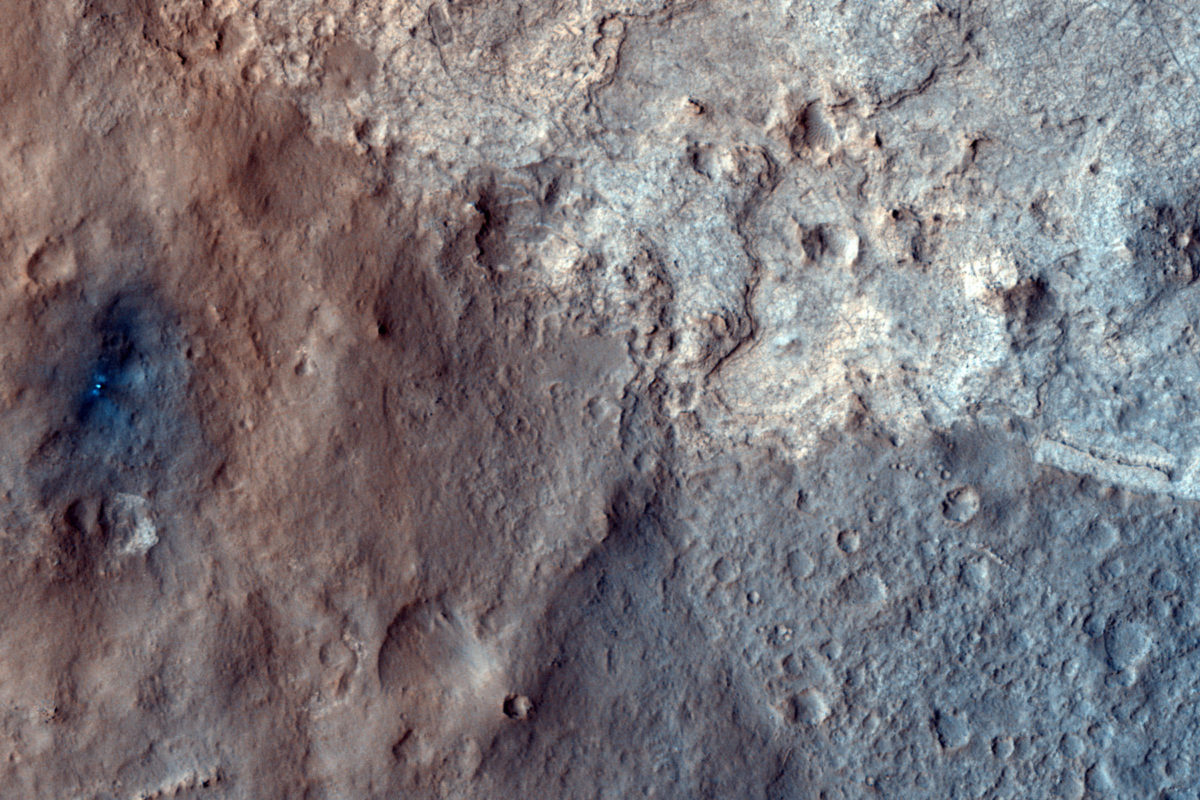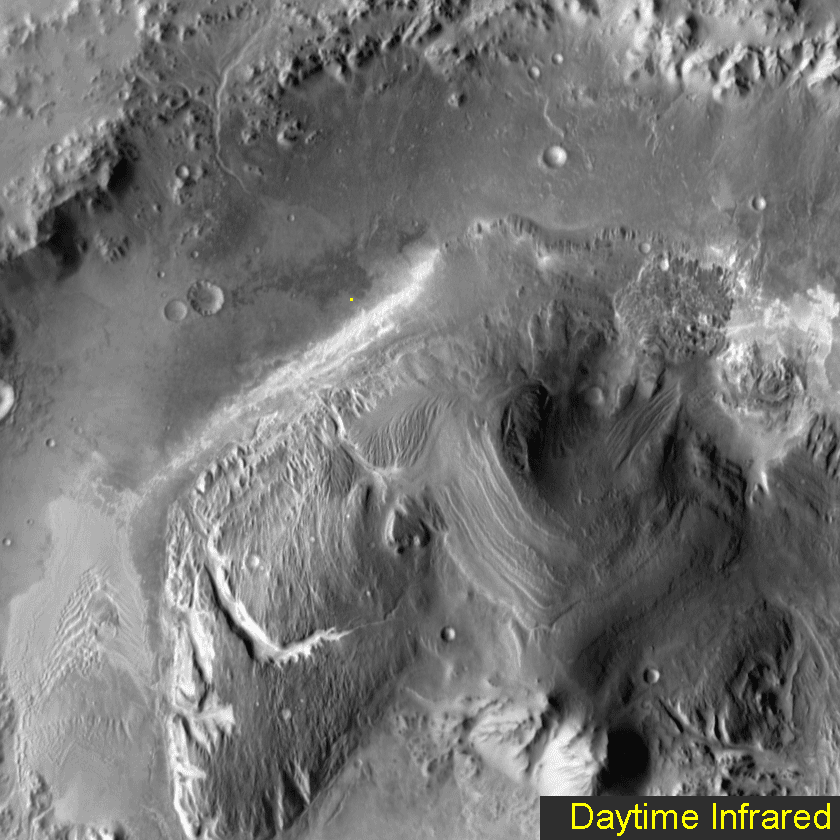Emily Lakdawalla • Aug 17, 2012
Curiosity sol 11 update: Decision to drive to "the high thermal inertia unit" and what that means
As I post this blog entry, it's just past midnight, in the wee hours of sol 12 for Curiosity on Mars. Back on Earth, there was a phone briefing this morning. The biggest news: according to project scientist John Grotzinger, the team has "pretty well decided" on Curiosity's first science target: the "triple junction" of three different rock types located a little more than 400 meters to the east of the rover's current position. They've named the spot "Glenelg."
Here is a view of the triple junction, cropped from the fantabulous HiRISE image taken 6 days after landing. I have stretched the heck out of the color to make the distinction among the three surface units easy to see. There is the reddish one, on which Curiosity sits; a light-toned one, occupying the top right quadrant; and a bluish one occupying the lower right quadrant. This isn't true color, but the relative color is correct -- one is redder, one is brighter, one is bluer.

The lightest unit in the image above is a rock type that's being referred to as "the high thermal inertia unit." I think it's time I explained what that means and why it's important.
Thermal inertia is a physical property of a material. If you know what "inertia" means, "thermal inertia" is exactly what it sounds like: a measure of the material's resistance to changes in temperature. Generally speaking, rocks and water have high thermal inertia. Dust and soil, with their large surface area relative to volume, have low thermal inertia.
Mars experiences wide swings in temperature because it lacks much of an atmosphere. The temperature at Curiosity's landing site varies by about 80 degrees Celsius or Kelvin each day-night cycle. A material that has high thermal inertia hangs on to its heat overnight, so if you look at Mars at night with a thermal imaging system, dark areas are dusty and bright areas are rocky. (This is, of course, an oversimplification, but it's a good first approximation of what nighttime thermal imaging data means.)
So here is a blink gif comparing what Gale looks like in daytime and nighttime infrared, as seen by the Thermal Emission Imaging System (THEMIS) on Mars Odyssey. The shading in daytime thermal imaging is dominated primarily by solar heating, so it looks like a regular photo in most places. It's easy to recognize the mound in the daytime infrared, but nighttime infrared is freaky-looking! It took me a while even to figure out what I was looking at -- in fact, that's why the daytime infrared image is there, to help me locate myself. I have put a little yellow square where Curiosity landed.

Okay. What does this tell us? In the nighttime infrared image you should be able to see, immediately north of Curiosity, a light-colored splash on the Gale crater floor. Notably, it's a somewhat darkish area in the daytime infrared. This is an area of high thermal inertia, resistant to changes in temperature: it's warm at night, and cool during the day.
To put it in its geological context, look to the northwest of Curiosity. You will see a beautiful branching channel system, that once collected flowing water from higher elevations and channeled it into Gale crater. Where it breaks out of the crater rim it develops a mildly sinuous pattern, and it ends in a fan-shaped sedimentary deposit. This is an "alluvial fan." The water in the channel system ran swiftly in the steeply sloped terrain on the crater rim and so was able to carry rocks along with it. As soon as the channel debouched onto the crater floor, it flowed with much less speed so couldn't carry that heavy material anymore; the sediment fell out of the water, with the biggest cobbles being dropped closest to the wall. The finest clays continued to be suspended in the water until it flowed no more, so were left at the end of the fan. That's clay-rich material deposited out of flowing water -- exactly the kind of environment Curiosity was sent to Mars to study. That high-thermal-inertia unit may be a rock formed out of those fine clays.
On the other hand, it might not be. We're going to find out one way or the other, because that's where Curiosity is headed as soon as she starts driving.
Here's a few other bullet-point updates from today's briefing.
- They'll start the drive after finishing Commissioning Activity Period 1B, during the so-called "Intermission." That's some time after next week. If they drive straight, it'll take 3 to 4 weeks to get there. (Go here for an explanation of what the Commissioning Activity Phases are.)
- However, they might interrupt the drive to perform Commissioning Activity Period 2 activities if they spy an area of nice fine-grained material that will be straightforward to pick up and deliver to the SAM and CheMin laboratory instruments.
- The DAN instrument operated successfully in active mode today, firing neutrons at the ground; furthermore, the RAD instrument detected the operation of DAN as expected. Grotzinger called this "great team collaboration."
- The REMS weather instrument is operating and Grotzinger promised that its principal investigator would present the first results from that next week. The current daily maximum temperature is 276 Kelvin (3 degrees Celsius, 37 degrees Fahrenheit).
- Roger Wiens showed an image of a little rock that the ChemCam team has picked out for their first shot, chosen more for its suitability for target practice than for science.
- I asked about the Mastcam-100 (the zoom one) and they do not plan to go through their initial pointing tests and so forth until after Commissioning Activity Period 1B is complete.
- They have not yet sequenced Mastcam-34 views that reach the top of the mound.
If 3 or 4 weeks seems like a long time for a 400-meter drive, it's because you're used to Opportunity's ridiculous one-sol drives of more than 100 meters. Remember, she was not doing that until way after her primary mission had ended, after her drivers had gotten very confident handling her on the repetitive, incredibly flat terrain of Meridiani Planum. It's possible that Curiosity will never achieve drives of that length, because all her flat-terrain driving is going to be early in the primary mission, when the drivers won't have achieved that confidence yet. By the time the driving becomes truly comfortable (though not easy -- it's never easy driving a rover on Mars!), Curiosity might already be in the much steeper terrain near the mound, and such long drives may not be possible.
Of course, I could be selling the rover drivers short here. For any rover drivers reading this, yes, that's a challenge. Achieve an over 100-meter drive with Curiosity and I'll bake you some cookies!
Support our core enterprises
Your support powers our mission to explore worlds, find life, and defend Earth. You make all the difference when you make a gift. Give today!
Donate

 Explore Worlds
Explore Worlds Find Life
Find Life Defend Earth
Defend Earth

